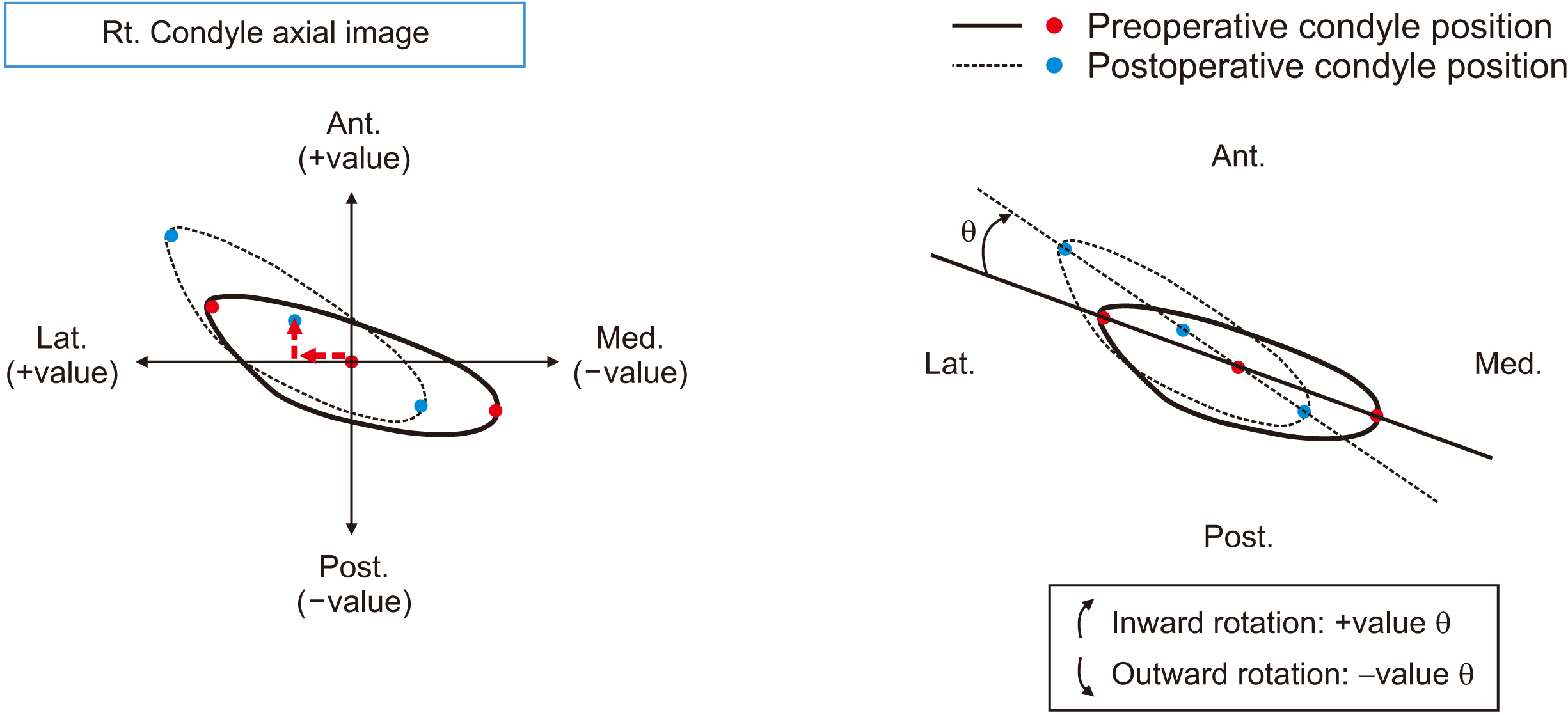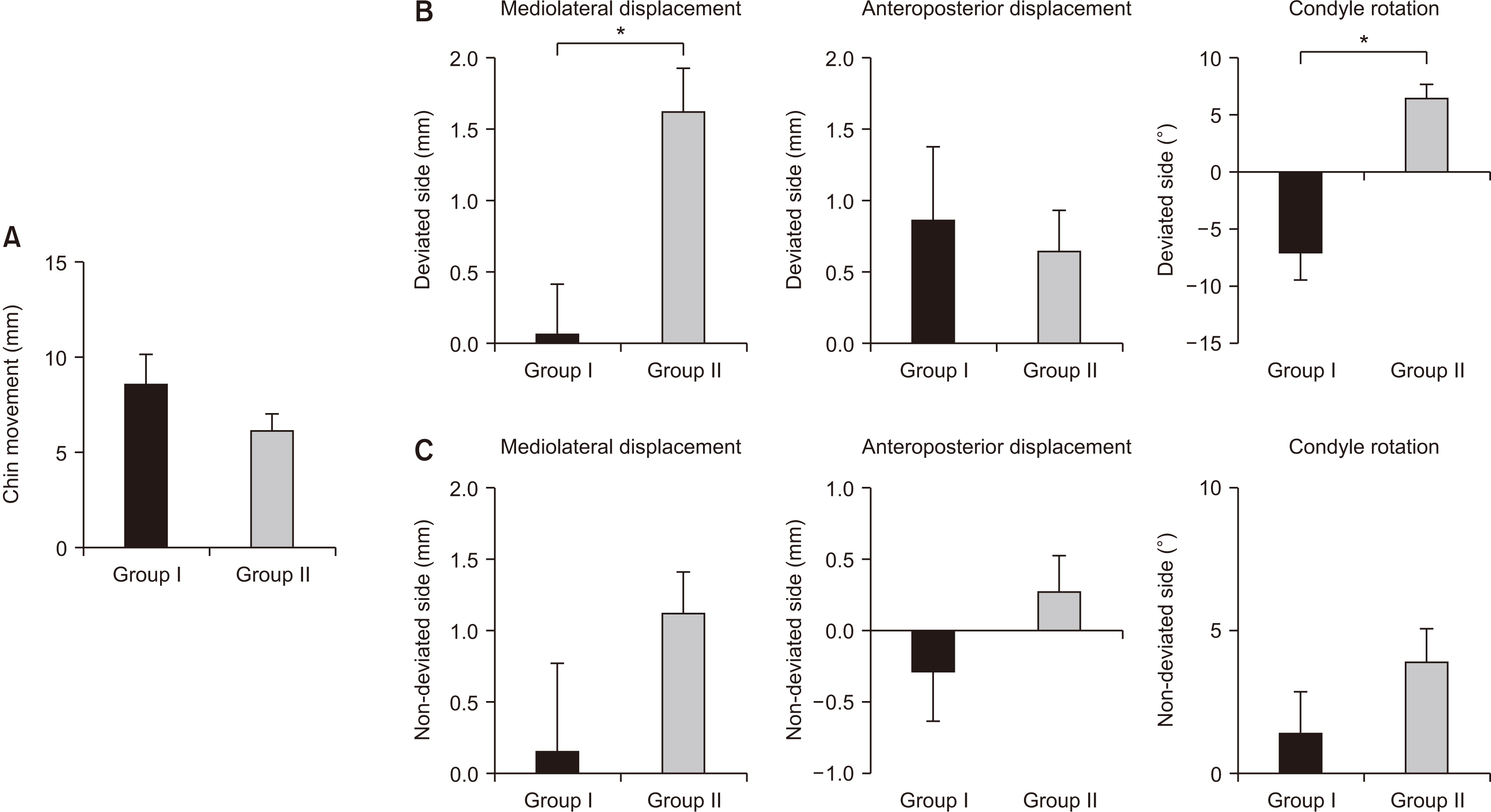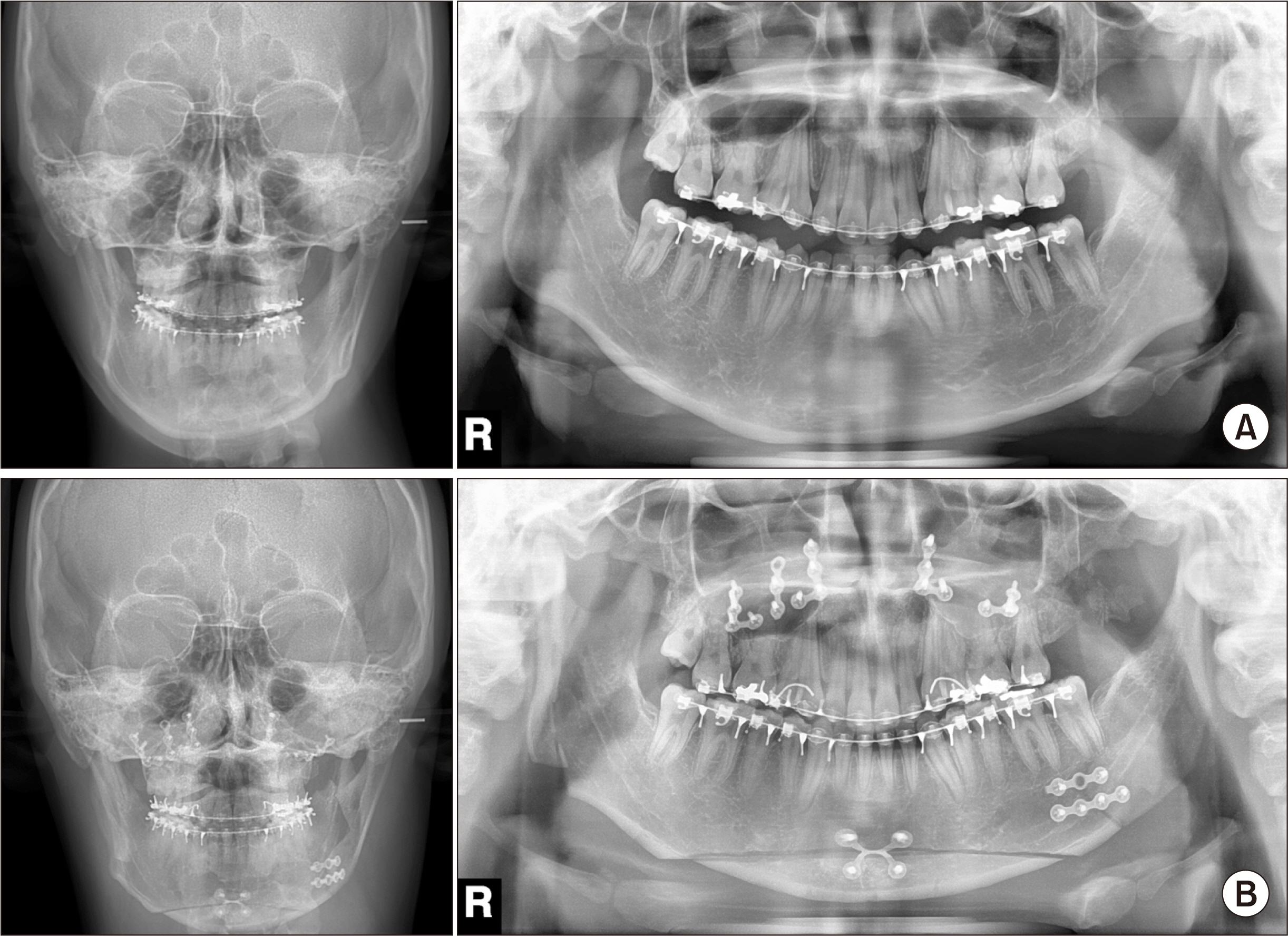J Korean Assoc Oral Maxillofac Surg.
2021 Oct;47(5):373-381. 10.5125/jkaoms.2021.47.5.373.
Positional changes of the mandibular condyle in unilateral sagittal split ramus osteotomy combined with intraoral vertical ramus osteotomy for asymmetric class III malocclusion
- Affiliations
-
- 1Department of Oral and Maxillofacial Surgery, College of Medicine, Dong-A University, Busan, Korea
- KMID: 2521793
- DOI: http://doi.org/10.5125/jkaoms.2021.47.5.373
Abstract
Objectives
In the present study, the effects of sagittal split ramus osteotomy (SSRO) combined with intraoral vertical ramus osteotomy (IVRO) for the treatment of asymmetric mandible in class Ⅲ malocclusion patients were assessed and the postoperative stability of the mandibular condyle and the symptoms of temporomandibular joint disorder (TMD) evaluated.
Materials and Methods
A total of 82 patients who underwent orthognathic surgery for the treatment of facial asymmetry or mandibular asymmetry at the Department of Oral and Maxillofacial Surgery, Dong-A University Hospital, from 2016 to 2021 were selected. The patients that underwent SSRO with IVRO were assigned to Group I (n=8) and patients that received bilateral SSRO (BSSRO) to Group II (n=10, simple random sampling). Preoperative and postoperative three-dimensional computed tomography (CT) axial images obtained for each group were superimposed. The condylar position changes and degree of rotation on the superimposed images were measured, and the changes in condyle based on the amount of chin movement for each surgical method were statistically analyzed.
Results
Group I showed a greater amount of postoperative chin movement. For the amount of mediolateral condylar displacement on the deviated side, Groups I and II showed an average lateral displacement of 0.07 mm and 1.62 mm, respectively, and statistically significantly correlated with the amount of chin movement (P=0.004). Most of the TMD symptoms in Group I patients who underwent SSRO with IVRO showed improvement.
Conclusion
When a large amount of mandibular rotation is required to match the menton to the midline of the face, IVRO on the deviated side is considered a technique to prevent condylar torque. In the present study, worsening of TMD symptoms did not occur after orthognathic surgery in any of the 18 patients.
Keyword
Figure
Cited by 1 articles
-
Treatment outcome and long-term stability of orthognathic surgery for facial asymmetry: A systematic review and meta-analysis
Yoon-Ji Kim, Moon-Young Kim, Nayansi Jha, Min-Ho Jung, Yong-Dae Kwon, Ho Gyun Shin, Min Jung Ko, Sang Ho Jun
Korean J Orthod. 2024;54(2):89-107. doi: 10.4041/kjod23.194.
Reference
-
References
1. Ellis E 3rd. 2007; A method to passively align the sagittal ramus osteotomy segments. J Oral Maxillofac Surg. 65:2125–30. https://doi.org/10.1016/j.joms.2007.02.005 . DOI: 10.1016/j.joms.2007.02.005. PMID: 17884553.
Article2. Ghali GE, Sikes JW Jr. 2000; Intraoral vertical ramus osteotomy as the preferred treatment for mandibular prognathism. J Oral Maxillofac Surg. 58:313–5. https://doi.org/10.1016/s0278-2391(00)90063-6 . DOI: 10.1016/s0278-2391(00)90063-6. PMID: 10716115.
Article3. Trauner R, Obwegeser H. 1957; The surgical correction of mandibular prognathism and retrognathia with consideration of genioplasty. II. Operating methods for microgenia and distoclusion. Oral Surg Oral Med Oral Pathol. 10:899–909. https://doi.org/10.1016/s0030-4220(57)80041-3 . PMID: 13452398.
Article4. Spiessl B. 1974; [Osteosynthesis in sagittal osteotomy using the Obwegeser-Dal Pont method]. Fortschr Kiefer Gesichtschir. 18:145–8. German. PMID: 4534071.5. Watzke IM, Heinrich A. 2002; The impact of bilateral sagittal split osteotomy on mandibular width and morphology. J Oral Maxillofac Surg. 60:502–4. discussion 505. https://doi.org/10.1053/joms.2002.31845 . DOI: 10.1053/joms.2002.31845. PMID: 11988923.
Article6. Proffit RP, White PJ. 1990. Surgical-orthodontics treatment. Mosby;Louis:7. Steinhäuser EW. 1996; Historical development of orthognathic surgery. J Craniomaxillofac Surg. 24:195–204. https://doi.org/10.1016/s1010-5182(96)80002-3 . DOI: 10.1016/s1010-5182(96)80002-3. PMID: 8880445.
Article8. Jung HD, Jung YS, Park HS. 2009; The chronologic prevalence of temporomandibular joint disorders associated with bilateral intraoral vertical ramus osteotomy. J Oral Maxillofac Surg. 67:797–803. https://doi.org/10.1016/j.joms.2008.11.003 . DOI: 10.1016/j.joms.2008.11.003. PMID: 19304037.
Article9. Rotskoff KS, Herbosa EG, Nickels B. 1991; Correction of condylar displacement following intraoral vertical ramus osteotomy. J Oral Maxillofac Surg. 49:366–72. discussion 373–4. https://doi.org/10.1016/0278-2391(91)90372-s . DOI: 10.1016/0278-2391(91)90372-s. PMID: 2005494.
Article10. Onizawa K, Schmelzeisen R, Vogt S. 1995; Alteration of temporomandibular joint symptoms after orthognathic surgery: comparison with healthy volunteers. J Oral Maxillofac Surg. 53:117–21. discussion 122–3. https://doi.org/10.1016/0278-2391(95)90383-6 . DOI: 10.1016/0278-2391(95)90383-6. PMID: 7830176.
Article11. Wolford LM, Reiche-Fischel O, Mehra P. 2003; Changes in temporomandibular joint dysfunction after orthognathic surgery. J Oral Maxillofac Surg. 61:655–60. discussion 661. https://doi.org/10.1053/joms.2003.50131 . DOI: 10.1053/joms.2003.50131. PMID: 12796870.
Article12. Lee JH, Park TJ, Jeon JH. 2015; Unilateral intraoral vertical ramus osteotomy and sagittal split ramus osteotomy for the treatment of asymmetric mandibles. J Korean Assoc Oral Maxillofac Surg. 41:102–8. https://doi.org/10.5125/jkaoms.2015.41.2.102 . DOI: 10.5125/jkaoms.2015.41.2.102. PMID: 25922823. PMCID: PMC4411725.
Article13. Panula K, Finne K, Oikarinen K. 2001; Incidence of complications and problems related to orthognathic surgery: a review of 655 patients. J Oral Maxillofac Surg. 59:1128–36. discussion 1137. https://doi.org/10.1053/joms.2001.26704 . DOI: 10.1053/joms.2001.26704. PMID: 11573165.
Article14. Hwang SJ, Haers PE, Zimmermann A, Oechslin C, Seifert B, Sailer HF. 2000; Surgical risk factors for condylar resorption after orthognathic surgery. Oral Surg Oral Med Oral Pathol Oral Radiol Endod. 89:542–52. https://doi.org/10.1067/moe.2000.105239 . DOI: 10.1067/moe.2000.105239. PMID: 10807709.
Article15. Dujoncquoy JP, Ferri J, Raoul G, Kleinheinz J. 2010; Temporomandibular joint dysfunction and orthognathic surgery: a retrospective study. Head Face Med. 6:27. https://doi.org/10.1186/1746-160X-6-27 . DOI: 10.1186/1746-160X-6-27. PMID: 21083902. PMCID: PMC2998459.
Article16. Al-Moraissi EA, Wolford LM, Perez D, Laskin DM, Ellis E 3rd. 2017; Does orthognathic surgery cause or cure temporomandibular disorders? A systematic review and meta-analysis. J Oral Maxillofac Surg. 75:1835–47. https://doi.org/10.1016/j.joms.2017.03.029 . DOI: 10.1016/j.joms.2017.03.029. PMID: 28419845.
Article17. Jung HD, Kim SY, Park HS, Jung YS. 2015; Orthognathic surgery and temporomandibular joint symptoms. Maxillofac Plast Reconstr Surg. 37:14. https://doi.org/10.1186/s40902-015-0014-4 . DOI: 10.1186/s40902-015-0014-4. PMID: 26029683. PMCID: PMC4446569.
Article18. Kang MG, Yun KI, Kim CH, Park JU. 2010; Postoperative condylar position by sagittal split ramus osteotomy with and without bone graft. J Oral Maxillofac Surg. 68:2058–64. https://doi.org/10.1016/j.joms.2009.12.015 . DOI: 10.1016/j.joms.2009.12.015. PMID: 20728029.
Article19. Ueki K, Degerliyurt K, Hashiba Y, Marukawa K, Nakagawa K, Yamamoto E. 2008; Horizontal changes in the condylar head after sagittal split ramus osteotomy with bent plate fixation. Oral Surg Oral Med Oral Pathol Oral Radiol Endod. 106:656–61. https://doi.org/10.1016/j.tripleo.2008.03.016 . DOI: 10.1016/j.tripleo.2008.03.016. PMID: 18602292.
Article20. Yang HJ, Hwang SJ. 2014; Change in condylar position in posterior bending osteotomy minimizing condylar torque in BSSRO for facial asymmetry. J Craniomaxillofac Surg. 42:325–32. https://doi.org/10.1016/j.jcms.2013.05.021 . DOI: 10.1016/j.jcms.2013.05.021. PMID: 23816144.
Article21. Epker BN, Stella JP, Fish LC. 1999. Dentofacial deformities: integrated orthodontic and surgical correction. 2nd ed. Mosby;St. Louis:22. Naran S, Steinbacher DM, Taylor JA. 2018; Current concepts in orthognathic surgery. Plast Reconstr Surg. 141:925e–36e. https://doi.org/10.1097/PRS.0000000000004438 . DOI: 10.1097/PRS.0000000000004438. PMID: 29794714.
Article
- Full Text Links
- Actions
-
Cited
- CITED
-
- Close
- Share
- Similar articles
-
- Unilateral intraoral vertical ramus osteotomy and sagittal split ramus osteotomy for the treatment of asymmetric mandibles
- Soft Tissue Change After Single Jaw(mandible) Surgery in Skeletal Class III Malocclusion
- Skeletal relapse pattern after sagittal split ramus osteotomy of mandibular prognathic patient
- Surgical correction of maxillofacial deformity with fibrous-osseous lesion of mandible using the intraoral vertical ramus osteotomy
- Condylar volume and positional changes following a bilateral sagittal split ramus osteotomy in skeletal class II and III malocclusions







